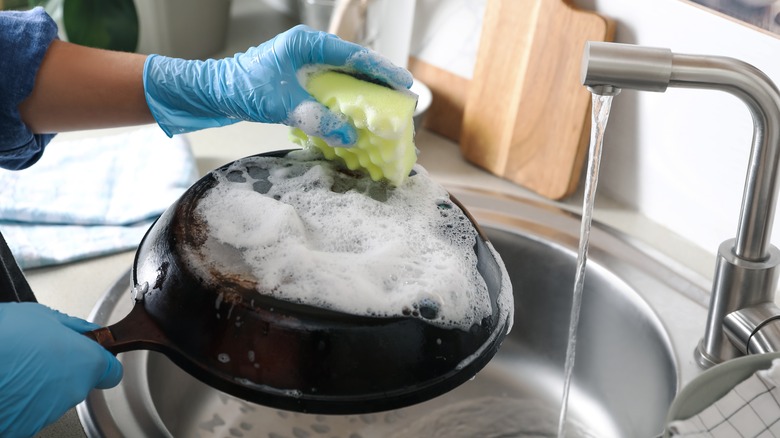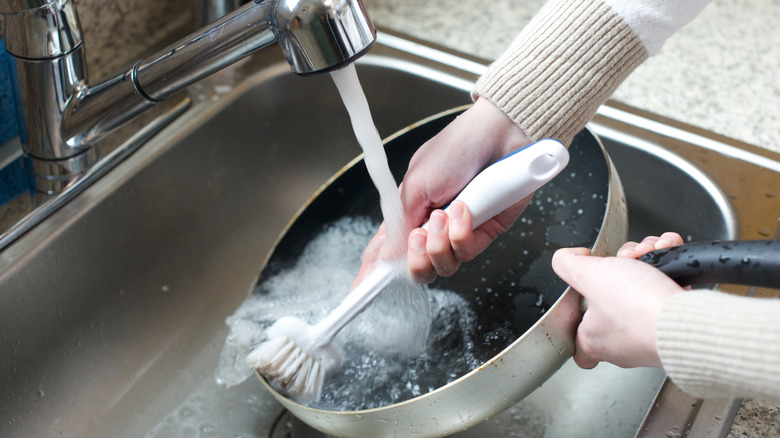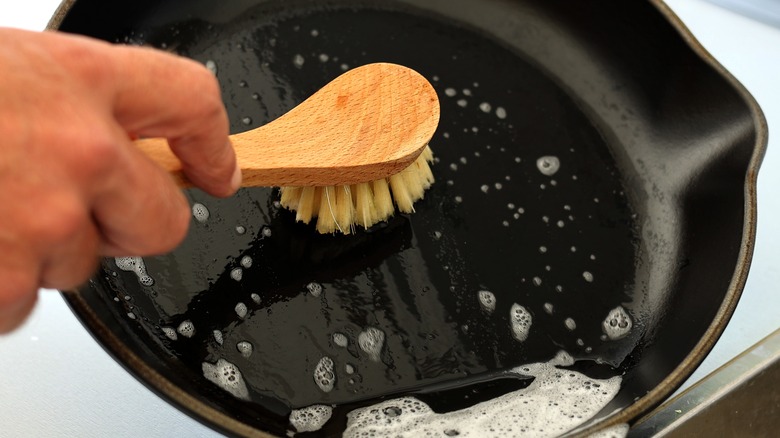Washing A Hot Pan In Water Is A Big Mistake. Here's Why
We may receive a commission on purchases made from links.
Moving a hot pan from the stovetop to the sink and soaking it in water is tempting for many reasons. For one, the water starts washing off cooking residue before it has time to cool and harden. It's also just an easy way to declutter the stovetop quickly. Plus, you may need to clean the frying pan quickly to continue making a different dish. But did you know that washing a pan while it's still hot can shorten its lifespan or even cause immediate damage like warping? This damage stems from a phenomenon known as "thermal shock" — a material's propensity to contract and expand unevenly in response to temperature changes.
In cookware, thermal shock can occur when the item undergoes a rapid, major temperature change, either from hot to cold or vice versa. For example, taking a scorching-hot frying pan (which may be as hot as 450 degrees Fahrenheit) and placing it under water that's about 120 degrees causes an instantaneous change of over 300 degrees. Thanks to the sudden cooling, the contraction of the material can cause the pan to warp to a point where the pan will no longer distribute heat evenly for proper cooking. Thermal shock doesn't just damage non-stick or stainless steel pans — allowing this cleaning mistake to happen can ruin cast iron pans, too. Here's how to wash different types of cookware properly without causing premature wear or outright damage.
How to wash non-stick pans properly after cooking
Non-stick cookware is particularly prone to warping due to thermal shock because its construction is usually lighter than that of stainless steel or cast iron pans. That's why it's important to let these pans cool to room temperature before you submerge it with water. Once it's no longer hot, don't just throw the pan in the dishwasher. While some pans are labeled dishwasher-safe, the high water temperatures it will be subjected to during the sanitizing phase may damage the non-stick coating over time. Handwashing is a safer method that's bound to prolong the pan's useful lifespan.
However, there are a few mistakes that can damage a non-stick pan with handwashing even if it's had time to cool down. For example, if you simply give the pan a quick wipe instead of cleaning it meticulously, tiny bits of food and cooking oil may remain on the surface. When you use the pan next, these remnants will not only throw off the taste and aroma of the dish you're preparing, but they can also easily turn into burn marks and make the next cleanup a nightmare. Conversely, using abrasive materials to get rid of stubborn burn spots is another bad practice with non-stick pans. These materials can scratch the teflon coating easily, which could expose the foods you cook to harmful synthetic chemicals like PFAS and micro- and nanoplastics. Instead, stick with using sponges or soft-bristle brushes when washing a non-stick pan.
How to wash cast iron and stainless steel pans after cooking
After-cleaning care is an important aspect of caring for your cast iron pan, as they're susceptible to rust. Before you clean the pan, allow it to cool to the point where you can comfortably touch it — waiting for it to reach all the way down to room temperature will make the cleanup harder. Begin by wiping it with a clean sponge or cloth. If this gets rid of all visible food and oil residue, you're done — cleaning the pan any further will only degrade the quality of the seasoning on its surface.
However, if bits of food remain stuck to the pan, wash the pan with warm water and use a bamboo or chainmail scrubber like this one from Amazon to remove the residue. Once the pan is clean, dry it with a lint-free towel, then heat it over low heat for up to 10 minutes. This process evaporates any remaining water particles from the pan. While it's still hot, rub the pan with a bit of oil or cast iron seasoning, then store the pan when it finally cools.
Cleaning stainless steel pans is relatively straightforward. You can either wash them by hand with dish soap and water or add them to your dishwasher load. The key thing to remember is that stainless steel pans are corrosion-resistant, but not corrosion-proof, so it's best not to soak them overnight. Instead, wash them quickly and dry them right after washing.


